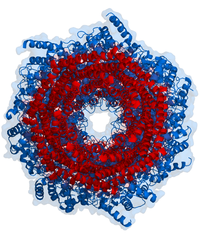
Photo from wikipedia
The 20S proteasome is the main protease for the degradation of oxidatively damaged and intrinsically disordered proteins. When accumulation of disordered or oxidatively damaged proteins exceeds proper clearance in neurons,… Click to show full abstract
The 20S proteasome is the main protease for the degradation of oxidatively damaged and intrinsically disordered proteins. When accumulation of disordered or oxidatively damaged proteins exceeds proper clearance in neurons, imbalanced pathway signaling or aggregation occurs, which have been implicated in the pathogenesis of several neurological disorders. Screening of the NIH Clinical Collection and Prestwick libraries identified the neuroleptic agent chlorpromazine as a lead agent capable of enhancing 20S proteasome activity. Chemical manipulation of chlorpromazine abrogated its D2R receptor binding affinity while retaining its ability to enhance 20S mediated proteolysis at low micromolar concentrations. The resulting small molecule enhancers of 20S proteasome activity induced the degradation of intrinsically disordered proteins, α-synuclein, and tau but not structured proteins. These small molecule 20S agonists can serve as leads to explore the therapeutic potential of 20S activation or as new tools to provide insight into the yet unclear mechanics of 20S-gate regulation.
Journal Title: ACS chemical biology
Year Published: 2017
Link to full text (if available)
Share on Social Media: Sign Up to like & get
recommendations!